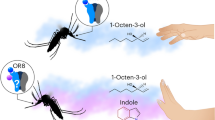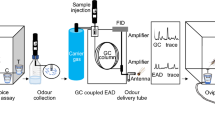Abstract
Oviposition pheromones specifically influence the females of many insects to lay eggs in the sites resulting in more egg deposition. A previous report describes the principal role of n-heneicosane (C21) identified and characterized from the larval cuticle of Aedes aegypti (L.) in attracting the gravid mosquitoes to oviposit in treated substrates among other chemical components. However, the means by which this compound is perceived by the females for oviposition has not been reported. In this study, we have recorded the peripheral olfactory responses from the antenna of Ae. aegypti from 10−7 g to 10−3 g doses of n-heneicosane. The EAG response of female mosquitoes increased in a dose-dependent manner with increasing stimulus strength. In the orientation assay using Y-maze olfactometer, female mosquitoes were attracted to the odor plume of 10−6 g and 10−5 g dose, while the higher dose of 10−3 g plume enforced repellency to gravid mosquitoes. The response to oviposition substrates by gravid Ae. aegypti females differed across the range of concentrations of n-heneicosane under multiple choice conditions, larger number of eggs were deposited in 10 ppm (10 mg/l) solutions compared to lower and higher concentrations indicating 10 ppm was most attractive. Application of n-heneicosane at 10 ppm in breeding habitats will be a useful method to attract the gravid mosquitoes using ovitraps for surveillance and monitoring. The possible use of this compound in monitoring of mosquito population in endemic areas in relevance to integrated vector management strategies is discussed in detail.



Similar content being viewed by others
References
Bentley MD, Day FJ (1989) Chemical ecology and behavioural aspects of mosquito oviposition. Annu Rev Entomol 34:401–421
Bentley MD, McDaniel IN, Davis EE (1982) Studies of 4-methyl-cyclohexanal: an Aedes triseriatus (Diptera: Culicidae) oviposition attractant. J Med Entomol 19:589–592
Blackwell A, Johnson SN (2000) Electrophysiological investigation of larval water and potential oviposition chemo-attractants for Anopheles gambiae s.s. Ann Trop Med Parasitol 94:389–398
Blackwell A, Mordue (Luntz) AJ, Hansson BS, Wadhams LJ, Pickett JA (1993) A behavioural and electrophysiological study of oviposition cues for Culex quinquefasciatus. Physiol Entomol 18:343–348
Bowen MF (1991) The sensory physiology of host-seeking behavior in mosquitoes. Annu Rev Entomol 36:139–158
Carlson DA, Schlein Y (1991) Unusual polymethyl alkenes in tsetse flies acting as abstinon in Glossina morsitans. J Chem Ecol 17:267–284
Carlson DA, Mayer MS, Silhacek DL, James JD, Beroza M, Bierl BA (1971) Sex attractant pheromone of the house fly: isolation, identification and synthesis. Science 174:76–77
Carlson DA, Langley PA, Huyton P (1978) Sex pheromone of the tsetse fly: isolation, identification and synthesis of contact aphrodisiacs. Science 201:750–753
Chickos JS, Hanshaw W (2004) Vapor pressures and vaporization enthalpies of the n-alkanes from C21–C30 at T = 298.15 K by correlation gas chromatography. J Chem Eng Data 49:77–85
Ganesan K, Mendki MJ, Suryanarayana MVS, Prakash S, Malhotra RC (2006) Studies of Aedes aegypti (Diptera: Culicidae) ovipositional responses to newly identified semiochemicals from conspecific eggs. Aust J Entomol 45:75–80
Geier M, Boeckh J (1999) A new Y-tube olfactometer for mosquitoes to measure the attractiveness of host odours. Entomol Exp Appl 92:9–19
Howard RW, Blomquist GJ (1982) Chemical ecology and biochemistry of insect hydrocarbons. Annu Rev Entomol 27:149–172
Howard RW, Blomquist GJ (2005) Ecological, behavioural, and biochemical aspects of insect hydrocarbons. Annu Rev Entomol 50:371–393
Huang J, Walker ED, Giroux PY, Vulule J, Miller JR (2005) Ovipositional site selection by Anopheles gambiae: influences of substrate moisture and texture. Med Vet Entomol 19:442–450
Huang J, Miller JR, Chen S, Vulule JM, Walker ED (2006) Anopheles gambiae (Diptera: Culicidae) oviposition in response to agarose media and cultured bacterial volatiles. J Med Entomol 43:498–504
Huyton PM, Langley PA, Carlson DA, Coates TW (1980) The role of sex pheromones in initiation of copulatory behaviour by male tsetse flies, Glossina morsitans morsitans. Physiol Entomol 5:243–252
Ikeshoji T, Mulla MS (1970) Over-crowding factors of mosquito larvae. J Econ Entomol 63:90–96
Ikeshoji T, Mulla MS (1974) Overcrowding factors of mosquito larvae: isolation and chemical identification. Environ Entomol 3:482–486
Kramer WL, Mulla MS (1979) Oviposition attractants and repellents of mosquitoes: oviposition responses of Culex mosquitoes to organic infusions. Environ Entomol 8:1111–1117
Law JH, Regnier FE (1971) Pheromones. Annu Rev Biochem 40:533–548
Leal WS (2005) Pheromone reception. Topics Curr Chem 240:1–36
Macklay JW (1977) Attractants and body hydrocarbon constituents of the horn fly, Haematobia irritans (L.). University of Florida, Gainesville, 129 p
McCall PJ (2002) Chemoecology of oviposition in insects of medical and veterinary importance. In: Hilker M, Meiners T (eds) Chemoecology of insect eggs and egg deposition. Blackwell, Berlin, pp 265–290
McCall PJ, Cameron MM (1995) Oviposition pheromones in insect vectors. Parasitol Today 11:352–355
Mendki MJ, Ganesan K, Prakash S, Suryanarayana MVS, Malhotra RC, Rao KM, Vaidyanathaswamy R (2000) Heneicosane: an oviposition-attractant pheromone of larval origin in Aedes aegypti mosquito. Curr Sci 78:1295–1296
Millar JG (2000) Polyene hydrocarbons and expoxides: a second major class of lepidopteran sex attractant pheromones. Annu Rev Entomol 45:575–604
Moore CG, Fisher BR (1969) Competition in mosquitoes. Density and species ratio effects on growth, mortality, fecundity and production of growth retardant. Ann Entomol Soc Am 62:1325–1331
Muhammed S, Butler JF, Carlson DA (1975) Stable fly sex attractant and mating pheromones found in female body hydrocarbons. J Chem Ecol 1:387–398
Oguma Y, Nemoto T, Kuwhara Y (1992a) (Z)-11-Pentacosane is the major sex pheromone component in Drosophila virilis (Diptera). Chemoecology 3:60–64
Oguma Y, Nemoto T, Kuwhara Y (1992b) A sex pheromone study of fruit fly Drosophila virilis Sturtevant (Diptera: Drosophilidae): additive effect of cuticular alkadienes to the major sex pheromone. Appl Ent Zool 27:499–505
Plimmer JR, Inscoe MN, McGovern TP (1982) Insect attractants. Annu Rev Pharmacol Toxicol 22:297–320
Puri SN, Mendki MJ, Sukumaran D, Ganesan K, Prakash S, Sekhar K (2006) Electroantennogram and behavioral responses of Culex quinquefasciatus (Diptera: Culicidae) females to chemicals found in human skin emanations. J Med Entomol 43:207–217
Renou M, Guerrero A (2000) Insect parapheromones in olfaction research and semiochemical-based pest control strategies. Annu Rev Entomol 48:605–630
Rogoff WM, Beltz AD, Johnson JD, Plapp FW (1964) A sex pheromone in the housefly Musca domestica L. J Insect Physiol 10:239–246
Sharma KR, Seenivasagan T, Rao AN, Ganesan K, Agarwal OP, Malhotra RC, Prakash S (2008) Oviposition responses of Aedes aegypti and Aedes albopictus to certain fatty acid esters. Parasitol Res 103:1065–1073
Sokal RR, Rohlf FJ (1981) Biometry. Freeman, San Francisco
Takken W, van Loon JJ, Adam W (2001) Inhibition of host-seeking response and olfactory responsiveness in Anopheles gambiae following blood feeding. J Insect Physiol 47:303–310
Uebel EC, Sonnet PE, Menzer RE, Miller RW, Lusby WR (1977) Mating-stimulant pheromone and cuticular lipid constituents of the little house fly, Fannia canicularis (L.). J Chem Ecol 3:269–278
Acknowledgements
We gratefully acknowledge all the members of Entomology Division (Defence Research and Development Establishment) for various help and technical support in maintaining the mosquito culture for bio-evaluation and the financial support from Project DRDE-175 of our establishment.
Author information
Authors and Affiliations
Corresponding author
Rights and permissions
About this article
Cite this article
Seenivasagan, T., Sharma, K.R., Sekhar, K. et al. Electroantennogram, flight orientation, and oviposition responses of Aedes aegypti to the oviposition pheromone n-heneicosane. Parasitol Res 104, 827–833 (2009). https://doi.org/10.1007/s00436-008-1263-2
Received:
Accepted:
Published:
Issue Date:
DOI: https://doi.org/10.1007/s00436-008-1263-2




